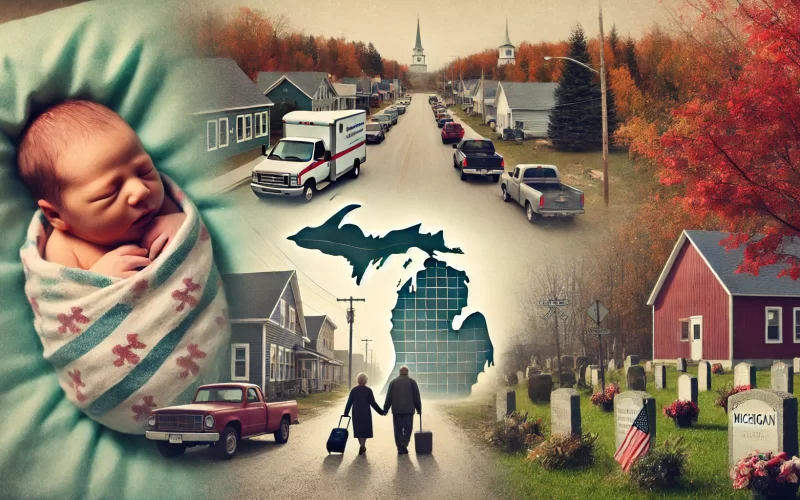Births, Deaths and Migrants: The U.P.’s Changing Population 2020-2024

A number of previously published Rural Insights articles have documented recent changes in the U.P.’s population, including the effects of Covid on the number of deaths as well as migration to and from the region.
This article examines newly available data from the Michigan Department of Health and Human Services on births and deaths, along with IRS Migration data to, provide an update on population changes in the UP between 2020-2023/4.
Covid had a significant impact on the region’s demography. At the height of the pandemic in 2020 and 2021, the region experienced a sharp increase in its number of deaths, from an annual average of 3,648 during the 2018-2019 period, to 4,056 in 2020-21; while its average number of births dropped from 2,494 to 2,372 during the same period.
More deaths than births would lead to a drop in an area’s population, except for the third component of population change, so-called net-migration (the difference between the numbers of in-migrants and out-migrants to an area). If more people are moving into an area than leaving, it may be enough to offset any negative difference between births and deaths.
In 2023, all U.P. counties, except for Houghton, had more deaths than births, so migration ends up becoming a source of population growth. Marquette County’s population, for example, increased by nearly 2,000 between 2020 and 2024, according to Census Bureau estimates, despite it having more deaths than births.
Births
The number of children born in the U.S. steadily declined from 4.2 million in 1990 to 3.6 million in 2024. The U.P. follows a similar pattern with 3,961 total births in 1990 and 2,163 in 2024, (Table 1), a 45% drop. Some of the reasons for this fall include a dip in teenage pregnancies and women delaying childbirth. Back in 1990, for example, 21 percent of births in Chippewa County were to mothers 30 years and older, in 2023 the figure is 36 percent; the equivalent figures for Marquette County are 28% and 57% respectively.
The uncertainty brought about the pandemic led to fewer births in 2022, but as its effects dissipated the number of births rebounded in 2023, with preliminary data for 2024 indicating a continuation of the long-term decline in births. The fall in total births is well illustrated by Marquette County. In 1990, 1,031 births were recorded; in 2024 the corresponding figure is 494.
One consequence of fewer children being born is a decline in school enrollment. Faced with fewer children, Marquette Area Public School administrators closed three elementary schools (Whitman, Parkview and Silver Creek) between 2001 andand a fourth (Vandenboom) in 2010.
Deaths
As a population ages the number of deaths would be expected to increase. One way of illustrating this phenomenon is examining how a place’s median age changes over time. The median age is defined as the age at the midpoint of the population, with half of the population being older than the median age and half of the population younger.
Delta county’s median age in 1990 was 35.1, by 2023 it was 47.6; indeed, the median age for most U.P. counties in 2023 was above 45, with Keweenaw County having the highest value at 56.7. Simply put, the higher the proportion of aged people the more deaths. Since 1990, the total number of deaths increased from 3,171 to 3,500 in 2023 (Table 1).
Comparing each county’s number of births with its number of deaths in 2023 shows that, with the exception of Houghton and Menominee, all have more deaths than births (Table 2).
Migration
The importance of migration to maintaining the region’s population is illustrated by IRS data on county in-migration and outmigration. These data are based on address changes on individual income tax returns and do not include temporary migration such as a person who has a permanent residence in Green Bay but spends time at their summer home in the U.P.
Despite the fact that not all people file tax returns, the data clearly indicate the role of net-migration in contributing to the region’s population (Table 3). For the region as a whole, 1,390 more people moved to the U.P. than left between 2021-22. Net-migration was highest for Marquette, Iron, Dickinson, Chippewa and Menominee counties, while Michigan Tech’s role in graduating students who leave the area maybe partially responsible for Houghton’s net loss.
A comparison with comparable data for the 2014-15 period shows an increase in the number of people moving to the region (6,020 versus 11,296) while the number of people moving away has increased by a smaller margin (Table 4). The result: net migration in 2014-15 was -865, while in 2021-22 it was +1,390. This difference is illustrative of why most U.P. counties lost population during the 2010-2020 period. Since 2020, remote working and recruitment efforts (e.g. Remote Workforce Keweenaw) have helped boost the region’s population.
Midwestern, southern and western states that were net recipients of U.P. migrants during the 2010-20 period are now net suppliers of migrants to portions of the U.P. In Marquette County, in 2014-15 the three regions supplied 552 migrants; the equivalent figure for 2021-22 is 1,056. During the same period, the number of outmigrants to the same three regions went from 734 to 894.
The reversal in so-called Sunbelt states from being net recipients to net suppliers of migrants is particularly notable and reinforces a pattern previously reported in a Rural Insights article, Climate Change and Migration: Could Marquette County Become a Climate Haven?
Final Thoughts
There is little evidence to suggest there will be a reversal in the decline in the number of births within the U.P. Fewer births and more deaths from an aging population increases the importance of migration to maintaining the region’s population base.
Newcomers bring a welcome economic boost to local economies and the tax base while contributing to the area’s housing affordability crisis. As with most things in life, population change and its effects are complicated.










We need immigration into the UP. Immigrants can mitigate the current projections.
This is something I’ve been saying for at least the past year. Let the immigrants come and work, earn and spend their money in the UP since there are jobs available and not enough workers. As one example, in the Marinette / Menominee area Fincantieri Marine is so short of labor they’re paying contractors exorbitant wages to try and complete the needed work. It’s great to say that only if they bring skills to the area should they come here but people can learn as long as they have the desire and that’s all that’s needed. Companies are providing the schooling that’s needed to become “skilled” workers. They don’t even need to live in the area as people are driving from sometimes long distances in the UP to work. I believe most immigrants are just looking for a place to work and call home so they can have a safe and productive life despite what one of the specific political parties headed by our hateful president is saying.
Death figures are super-sketchy during Covid. Hospitals were being paid for reporting deaths that might actually have been “with Covid” as opposed to “from Covid.” I’m sure the results are skewed by this.
Amy, a death is a death. The cause of it does not skew the data.
Never before Covid has an order been issued to change death reporting. It was strange too that CDC etc. claimed flu had disappeared from the population so every ILI was Covid or pneumonia. People with pneumonia were denied antibiotics, they were told they had Covid pneumonia which had no treatment, these happened to my friend here in Marquette. So pneumonia in elderly went untreated. Elderly were also isolated and denied family visits. High-flow oxygen was also used which causes symptoms of ARDS. They now admit ventilators were never called for, eighty percent of people put on vents died. Illegal DNR orders were issued as in the case of Grace Schara whose Appleton, Wisconsin family fought for her life, sadly they lost. You can Google the lawsuit brought by the Schara family which goes to trial in June. I would like to see the death figures for the UP from March 2020 to June 2022 when “Covid” basically ended to see the ages of all who died “from Covid.” I suspect it skews to the elderly. Why do I think that? Because under Obamacare euthanasia is legal in America. https://ouramazinggrace.substack.com/p/is-euthanasia-legal-in-america
I agree with you Amy.
One of the most important jobs of any government health agency is to monitor deaths. Over time, robust statistics become available and predictions become more and more accurate. Flu season? Expect x number of deaths. Summer vacation? Expect y number of deaths. But when there far more deaths then predicted by these statistics, health agencies rightly freak out. What’s going on? Is there a new disease? A new strain of flu? A war we don’t know about? It’s their job to figure it out. It’s a basic function of government – why are our citizens dying in far greater numbers than predicted?
From March 2020 to February 2022 there may have been as many as 1.1 milllion excess deaths in the United States.
It simply doesn’t matter if it was “with Covid” or “from Covid”. It’s a ridiculous argument. Something caused all these excess deaths, and the culprit was this new disease called Covid-19.
Another very interesting article. Thank you
Great article – interesting and relevant – Tad
In-migration is only beneficial if the new arrivals bring skills to the area. It’s about quality, not quantity.
I brought my retirement money to the UP. I try to spend it locally, but with the loss of local retail and services, it is not as simple as I thought it would be to support my home.
Not a troll; i was born here, but spent my earning years downstate
Most of the jobs we are talking about do not take high-level skills. Right now they don’t have enough people to fill the positions even with quality by Americans. The only hope of the UP is to get a quantity of immigrants. These folks can be trained for many of these positions where there be boats in Menominee or in-care homes/facilities. If we do not get immigrants now, it will be more difficult later to get them because everybody’s gonna be trying to get them.
Very informative and easy to understand. Sometime statistical articles are difficult to understand.
Thank you Michael Broadway.
Good article. The decline in births is Another thing I don’t understand about the reliance on Tariffs. I get the hope to bring back manufacturing to the USA…makes sense. But who is going to take those jobs? How much will they pay? For instance, textile or shoe or even electronics assembly manufacturing isnt a high paying job. The decline in the birth rate coupled with a severe crackdown on immigration of the kind that takes lower paying jobs creates a problem with having enough workers to “man the looms.” My brother was in an assisted living facility in Northern Wisconsin. It was privately owned, nice place, but as with most care providers they struggled to keep staff in an area with a limited employment base. they raised wages, some new employees came on….then other homes raised rates..same problems. The owners sold out to a private equity fund which is owned in Saudi Arabia. they announced plans to build a new wing, but I havent a clue where they will find the employees to staff it? Honestly I am not trying to be political, just looking at this from an economic way. Its good to hear there is a small movement back to the U.P.
Any insight into the age of migrates? are we gaining young workers or more retires?
Great question!
Please:
Ask the politicians who represent the UP at the county, state and federal level to tell us:
… What are the most serious challenges facing the UP
… Where the UP is headed if not much changes
… Ask them what has to be done to improve prospects for the UP, in specific, concrete terms
… And what they will do as representatives to improve the future of the UP
When you get responses, summarize in a (near) future article. And tell us who did not bother to answer.
Great questions…would love to hear them answer!
Again an incomplete analysis. The decline in the birth rate is a national problem, not just a UP problem. More children need to be born. Contributing to this is the decline of the family. Note the number of children in the family has continued to decline. Likely the ease of obtaining abortions has contributed to the reduction in births. In addition, the in-migration numbers fail to consider the age of the in-mgrants. This is important to the analysis since many of the in-mgrants come to the UP to retire and likely have a much shorter life span than new borns. Michael, I challenge you to do a national analysis with a projection over the next 50 years.
We all need to remember that a lot of the methodology may not be as iron-clad as we’d like. There is a lot that goes into making those projections. Births and deaths are pretty hard numbers, but for instance in university towns like Houghton or Marquette the article mentions students leaving upon graduation as part of a net loss, at least as far as statistically.
However, what is just as interesting is realizing that if the college enrollment stays steady, at least, a new class of freshmen backfills that loss from of those who left; so where is the real loss? Part of that data comes from USPS address change data. Those address change forms at the post office don’t typically get filed until the graduate is leaving town. Many students never formally changed their address when they moved from their hometown to the dorms. Only when they moved into that off-campus house or apartment after a few years (where they started paying bills) did they actually establish an address in town. Up until then there was no formal address change and then as they approach graduation, many finally had established a local address that they need to then change. That formal change is just one dataset demographers use to make those projections. It’s not a perfect system.
Accuracy is extremely important as all of this data factors into revenue from the state for our local roads and governments. Population is part of the equation when both determining how much of the state’s gas tax is shared with local government so those local governments can maintain our roads and how much sales tax is returned local government to help fund police departments, operate parks, etc.
Broadway’s analysis serves as a crucial reminder of the complexities involved in demographic changes. Addressing these challenges will require multifaceted strategies, including policies that support family growth, economic diversification, and infrastructure development to accommodate and integrate new residents effectively.
Honestly after moving here 10 years ago with the hope of economic resurgence or any type of meaningful efforts at recovery for this area. I see little effort in regards to any economic expansion. And now with the BIG BEAUTIFUL BILL as Trump calls it. I can only surmise that the population of my county Gogebic will only be all the more underserved and fall all the more. With the total amount of folks in this county being Medicaid recipients their care and your hospital are nothing more than endangered species. Like Ontonagon county your medical care and health care have been gutted by the very same man many of you chose to vote for.
Writing is on the wall ………the dream is dead for all but the well insulated and greedy folks that have had their’s for generations. And really economic expansion of jobs coming back to America.
Nonsense…..as the only folks that may have considered these jobs are being driven out bye the fools that hate them.
LOL